Marketing and the Business Environment
VerifiedAdded on 2023/01/05
|14
|4381
|1
AI Summary
This report evaluates the marketing strategies of Unilever and ITC, analyzes the global factors affecting their business, and provides recommendations.
Contribute Materials
Your contribution can guide someone’s learning journey. Share your
documents today.
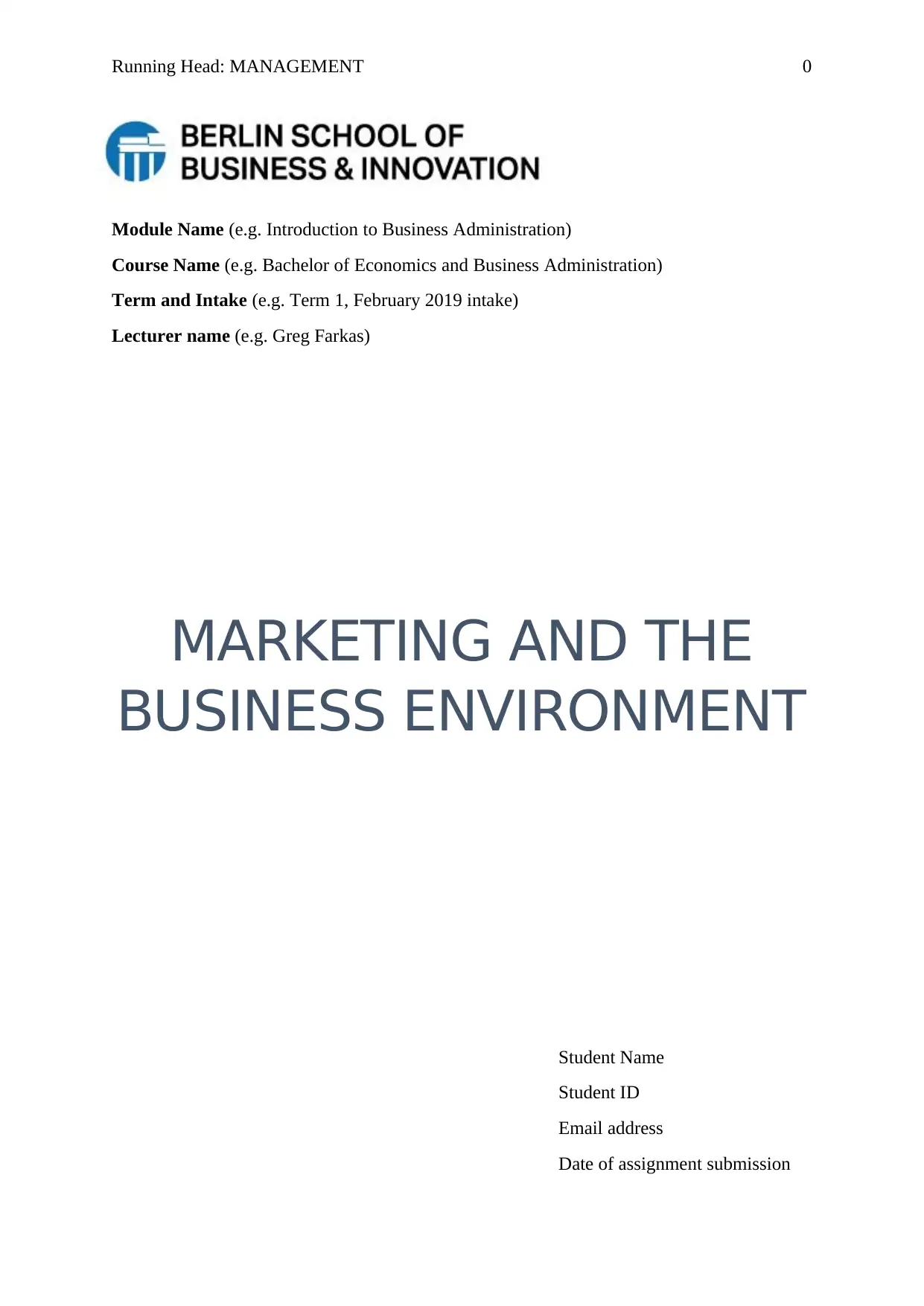
Running Head: MANAGEMENT 0
Module Name (e.g. Introduction to Business Administration)
Course Name (e.g. Bachelor of Economics and Business Administration)
Term and Intake (e.g. Term 1, February 2019 intake)
Lecturer name (e.g. Greg Farkas)
MARKETING AND THE
BUSINESS ENVIRONMENT
Student Name
Student ID
Email address
Date of assignment submission
Module Name (e.g. Introduction to Business Administration)
Course Name (e.g. Bachelor of Economics and Business Administration)
Term and Intake (e.g. Term 1, February 2019 intake)
Lecturer name (e.g. Greg Farkas)
MARKETING AND THE
BUSINESS ENVIRONMENT
Student Name
Student ID
Email address
Date of assignment submission
Secure Best Marks with AI Grader
Need help grading? Try our AI Grader for instant feedback on your assignments.
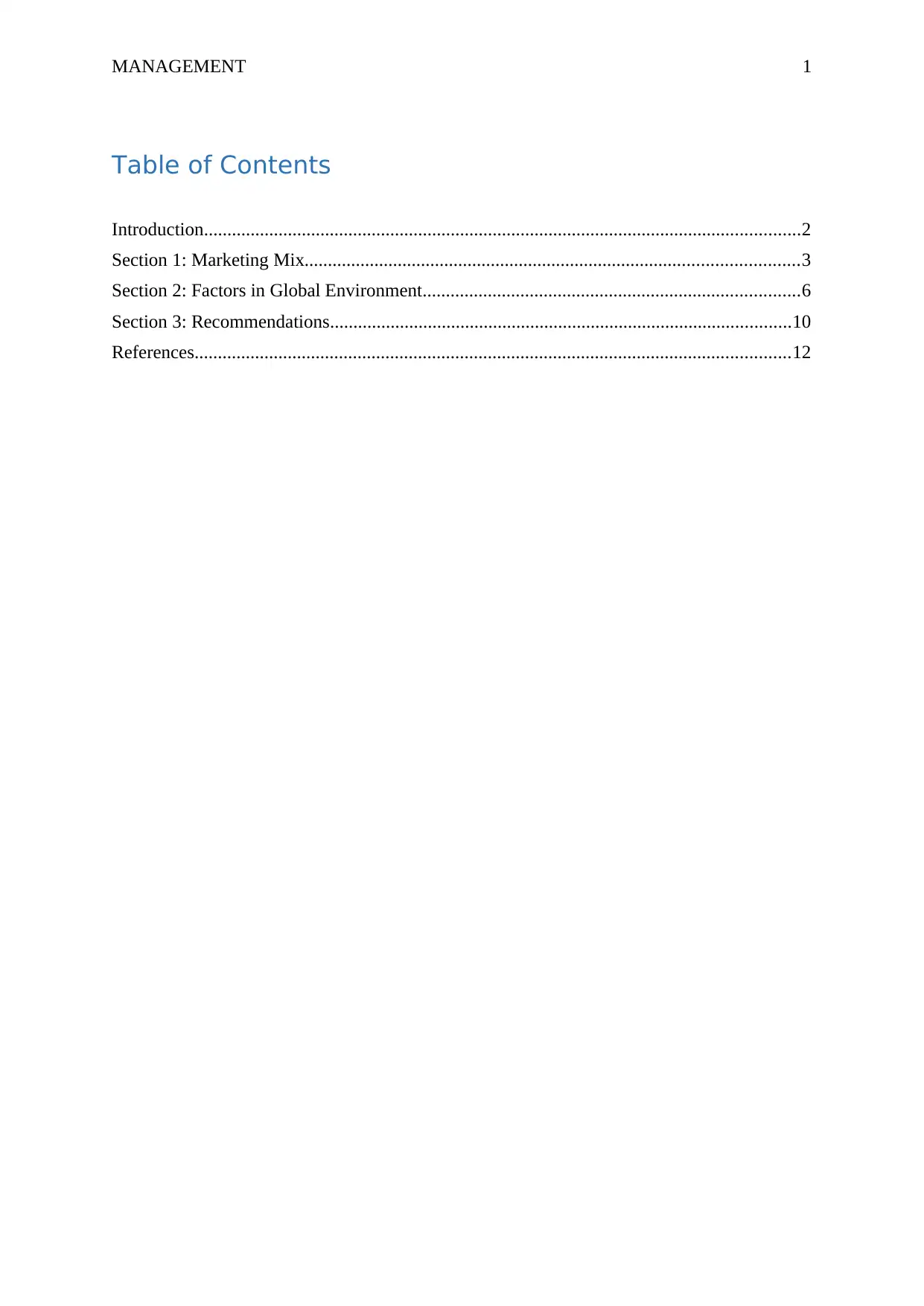
MANAGEMENT 1
Table of Contents
Introduction................................................................................................................................2
Section 1: Marketing Mix..........................................................................................................3
Section 2: Factors in Global Environment.................................................................................6
Section 3: Recommendations...................................................................................................10
References................................................................................................................................12
Table of Contents
Introduction................................................................................................................................2
Section 1: Marketing Mix..........................................................................................................3
Section 2: Factors in Global Environment.................................................................................6
Section 3: Recommendations...................................................................................................10
References................................................................................................................................12

MANAGEMENT 2
Introduction
Global markets and modern business conditions change the definition of marketing. In
today’s contemporary world, knowledge has become a fundamental resource. Marketing
enables knowledge management by creating possibilities for raising knowledge productivity
of several business functions and practices in the organisation (Ballantyne and Varey, 2008).
Other than this, effective marketing also enables organisation to deal with various significant
factors in the global environment in respective with the particular marketing mix approaches.
It also attempts to develop and maintain multiple perspectives on organisation commercial
activities.
This report is divided into three sections. The first section of the report includes evaluation
and comparison of marketing strategies of Unilever and ITC in extent with the marketing
mix. The second section depicts their main current offerings with the help of using an
industrial and organisational tool of analysis such as BCG and Porter 5 Forces. In the last
section, relevant recommendation is presented with using of Ansoff matrix, a strategic
planning tool offers a framework to help executives and management formulating strategies
for the future development and sustainability.
About the organizations
Unilever is one of the leading and world largest multinational company founded back in
1929. The company starts with a clear vision i.e. – to make sustainable living a
commonplace. The company believe that this is the best long-term way towards the growth of
their business. Other than this, their mission is to add vitality to the life of the consumers and
helping people in respect with the biggest issues of the world today, such as urbanization,
ageing population, altering diets and lifestyles. In 2018, Unilever Group earned revenue of
approximately 50.98 billion euros.
The next selected company for this report is ITC, which is an Indian multinational
conglomerate founded in 1910. The vision of ITC is to position itself as India most Valuable
Corporation through excellent performance and developing growing value for the Indian
economy and organisation stakeholders (itcportal.com, 2013). With regards to this, the
Introduction
Global markets and modern business conditions change the definition of marketing. In
today’s contemporary world, knowledge has become a fundamental resource. Marketing
enables knowledge management by creating possibilities for raising knowledge productivity
of several business functions and practices in the organisation (Ballantyne and Varey, 2008).
Other than this, effective marketing also enables organisation to deal with various significant
factors in the global environment in respective with the particular marketing mix approaches.
It also attempts to develop and maintain multiple perspectives on organisation commercial
activities.
This report is divided into three sections. The first section of the report includes evaluation
and comparison of marketing strategies of Unilever and ITC in extent with the marketing
mix. The second section depicts their main current offerings with the help of using an
industrial and organisational tool of analysis such as BCG and Porter 5 Forces. In the last
section, relevant recommendation is presented with using of Ansoff matrix, a strategic
planning tool offers a framework to help executives and management formulating strategies
for the future development and sustainability.
About the organizations
Unilever is one of the leading and world largest multinational company founded back in
1929. The company starts with a clear vision i.e. – to make sustainable living a
commonplace. The company believe that this is the best long-term way towards the growth of
their business. Other than this, their mission is to add vitality to the life of the consumers and
helping people in respect with the biggest issues of the world today, such as urbanization,
ageing population, altering diets and lifestyles. In 2018, Unilever Group earned revenue of
approximately 50.98 billion euros.
The next selected company for this report is ITC, which is an Indian multinational
conglomerate founded in 1910. The vision of ITC is to position itself as India most Valuable
Corporation through excellent performance and developing growing value for the Indian
economy and organisation stakeholders (itcportal.com, 2013). With regards to this, the
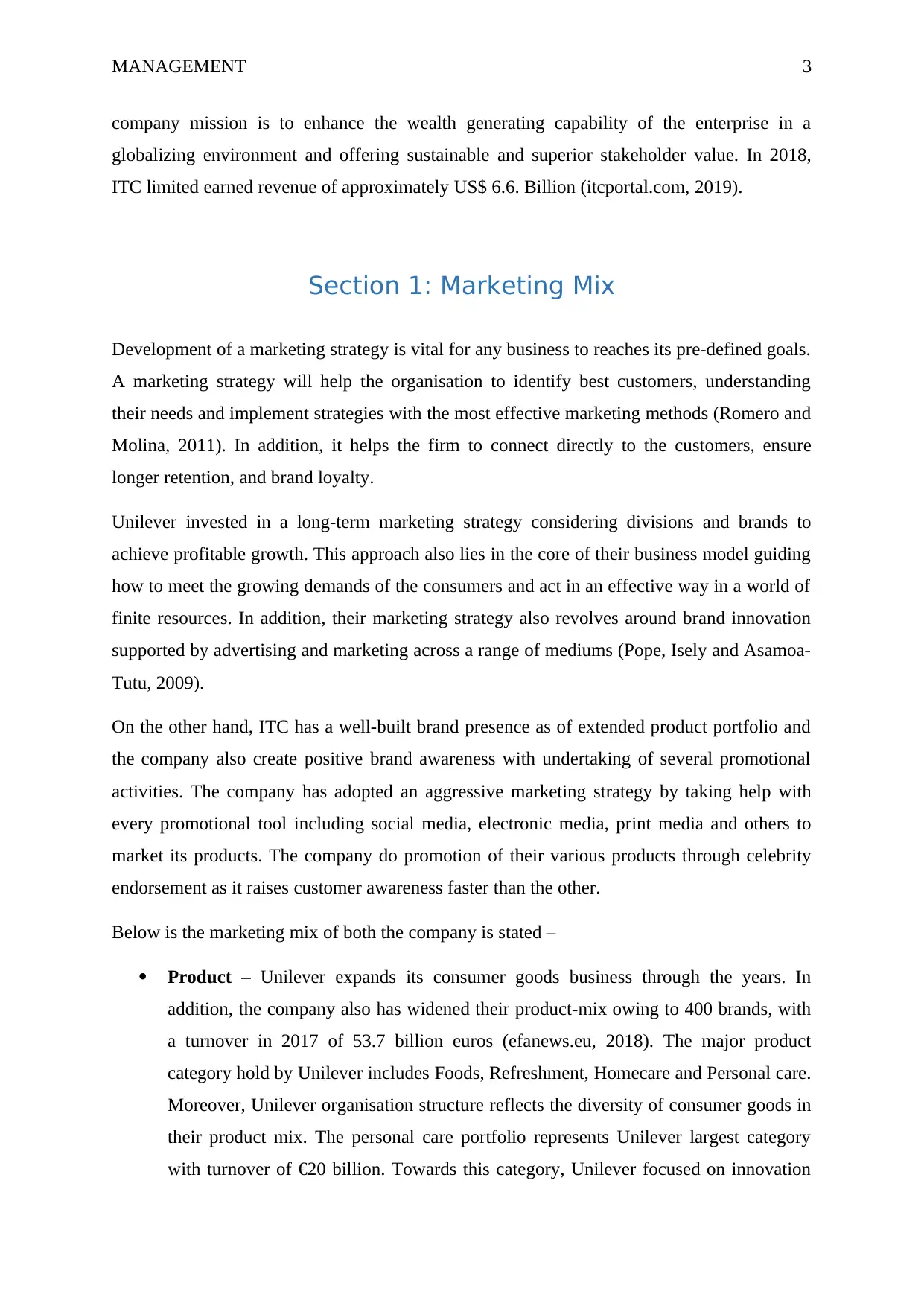
MANAGEMENT 3
company mission is to enhance the wealth generating capability of the enterprise in a
globalizing environment and offering sustainable and superior stakeholder value. In 2018,
ITC limited earned revenue of approximately US$ 6.6. Billion (itcportal.com, 2019).
Section 1: Marketing Mix
Development of a marketing strategy is vital for any business to reaches its pre-defined goals.
A marketing strategy will help the organisation to identify best customers, understanding
their needs and implement strategies with the most effective marketing methods (Romero and
Molina, 2011). In addition, it helps the firm to connect directly to the customers, ensure
longer retention, and brand loyalty.
Unilever invested in a long-term marketing strategy considering divisions and brands to
achieve profitable growth. This approach also lies in the core of their business model guiding
how to meet the growing demands of the consumers and act in an effective way in a world of
finite resources. In addition, their marketing strategy also revolves around brand innovation
supported by advertising and marketing across a range of mediums (Pope, Isely and Asamoa‐
Tutu, 2009).
On the other hand, ITC has a well-built brand presence as of extended product portfolio and
the company also create positive brand awareness with undertaking of several promotional
activities. The company has adopted an aggressive marketing strategy by taking help with
every promotional tool including social media, electronic media, print media and others to
market its products. The company do promotion of their various products through celebrity
endorsement as it raises customer awareness faster than the other.
Below is the marketing mix of both the company is stated –
Product – Unilever expands its consumer goods business through the years. In
addition, the company also has widened their product-mix owing to 400 brands, with
a turnover in 2017 of 53.7 billion euros (efanews.eu, 2018). The major product
category hold by Unilever includes Foods, Refreshment, Homecare and Personal care.
Moreover, Unilever organisation structure reflects the diversity of consumer goods in
their product mix. The personal care portfolio represents Unilever largest category
with turnover of €20 billion. Towards this category, Unilever focused on innovation
company mission is to enhance the wealth generating capability of the enterprise in a
globalizing environment and offering sustainable and superior stakeholder value. In 2018,
ITC limited earned revenue of approximately US$ 6.6. Billion (itcportal.com, 2019).
Section 1: Marketing Mix
Development of a marketing strategy is vital for any business to reaches its pre-defined goals.
A marketing strategy will help the organisation to identify best customers, understanding
their needs and implement strategies with the most effective marketing methods (Romero and
Molina, 2011). In addition, it helps the firm to connect directly to the customers, ensure
longer retention, and brand loyalty.
Unilever invested in a long-term marketing strategy considering divisions and brands to
achieve profitable growth. This approach also lies in the core of their business model guiding
how to meet the growing demands of the consumers and act in an effective way in a world of
finite resources. In addition, their marketing strategy also revolves around brand innovation
supported by advertising and marketing across a range of mediums (Pope, Isely and Asamoa‐
Tutu, 2009).
On the other hand, ITC has a well-built brand presence as of extended product portfolio and
the company also create positive brand awareness with undertaking of several promotional
activities. The company has adopted an aggressive marketing strategy by taking help with
every promotional tool including social media, electronic media, print media and others to
market its products. The company do promotion of their various products through celebrity
endorsement as it raises customer awareness faster than the other.
Below is the marketing mix of both the company is stated –
Product – Unilever expands its consumer goods business through the years. In
addition, the company also has widened their product-mix owing to 400 brands, with
a turnover in 2017 of 53.7 billion euros (efanews.eu, 2018). The major product
category hold by Unilever includes Foods, Refreshment, Homecare and Personal care.
Moreover, Unilever organisation structure reflects the diversity of consumer goods in
their product mix. The personal care portfolio represents Unilever largest category
with turnover of €20 billion. Towards this category, Unilever focused on innovation
Secure Best Marks with AI Grader
Need help grading? Try our AI Grader for instant feedback on your assignments.
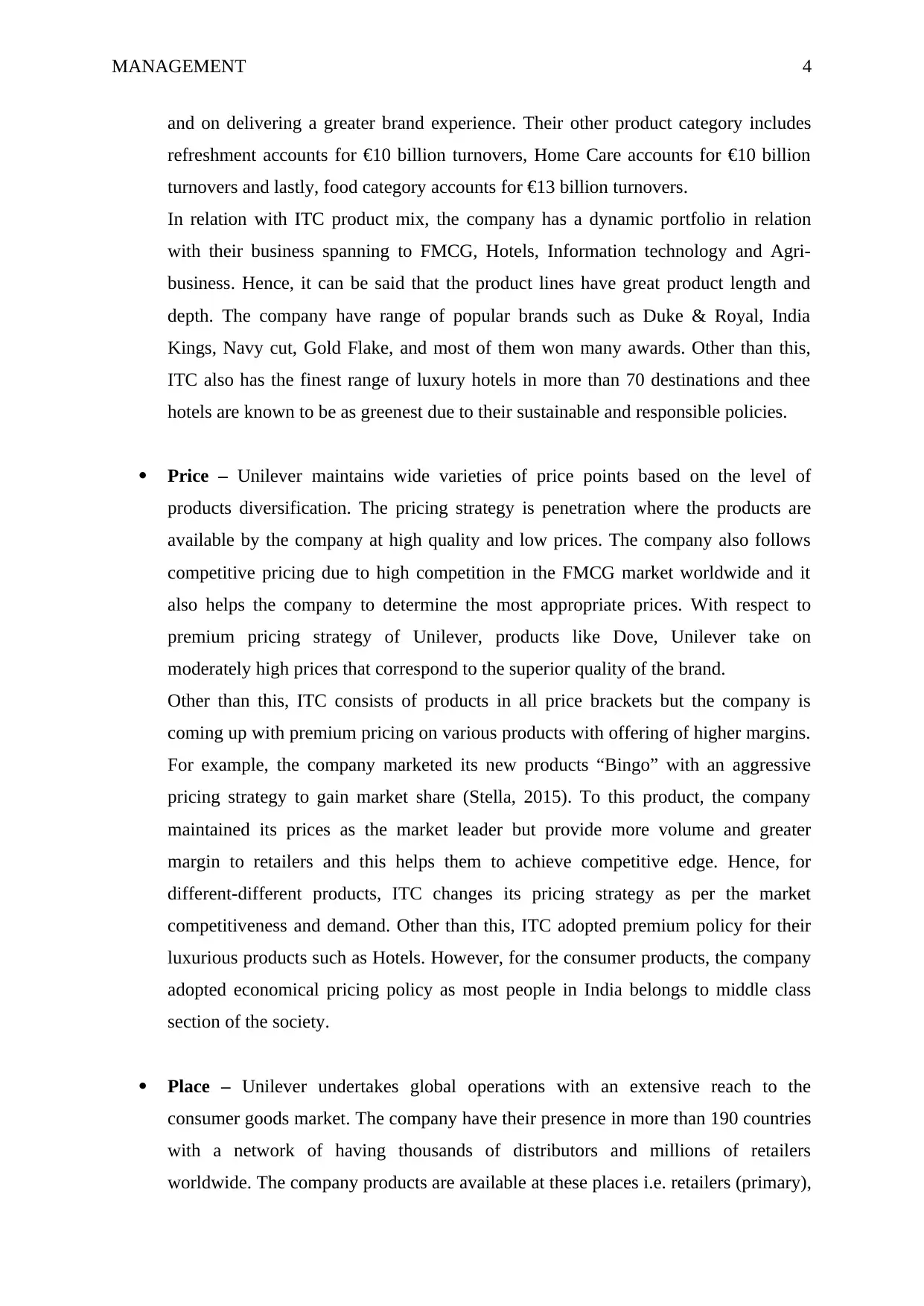
MANAGEMENT 4
and on delivering a greater brand experience. Their other product category includes
refreshment accounts for €10 billion turnovers, Home Care accounts for €10 billion
turnovers and lastly, food category accounts for €13 billion turnovers.
In relation with ITC product mix, the company has a dynamic portfolio in relation
with their business spanning to FMCG, Hotels, Information technology and Agri-
business. Hence, it can be said that the product lines have great product length and
depth. The company have range of popular brands such as Duke & Royal, India
Kings, Navy cut, Gold Flake, and most of them won many awards. Other than this,
ITC also has the finest range of luxury hotels in more than 70 destinations and thee
hotels are known to be as greenest due to their sustainable and responsible policies.
Price – Unilever maintains wide varieties of price points based on the level of
products diversification. The pricing strategy is penetration where the products are
available by the company at high quality and low prices. The company also follows
competitive pricing due to high competition in the FMCG market worldwide and it
also helps the company to determine the most appropriate prices. With respect to
premium pricing strategy of Unilever, products like Dove, Unilever take on
moderately high prices that correspond to the superior quality of the brand.
Other than this, ITC consists of products in all price brackets but the company is
coming up with premium pricing on various products with offering of higher margins.
For example, the company marketed its new products “Bingo” with an aggressive
pricing strategy to gain market share (Stella, 2015). To this product, the company
maintained its prices as the market leader but provide more volume and greater
margin to retailers and this helps them to achieve competitive edge. Hence, for
different-different products, ITC changes its pricing strategy as per the market
competitiveness and demand. Other than this, ITC adopted premium policy for their
luxurious products such as Hotels. However, for the consumer products, the company
adopted economical pricing policy as most people in India belongs to middle class
section of the society.
Place – Unilever undertakes global operations with an extensive reach to the
consumer goods market. The company have their presence in more than 190 countries
with a network of having thousands of distributors and millions of retailers
worldwide. The company products are available at these places i.e. retailers (primary),
and on delivering a greater brand experience. Their other product category includes
refreshment accounts for €10 billion turnovers, Home Care accounts for €10 billion
turnovers and lastly, food category accounts for €13 billion turnovers.
In relation with ITC product mix, the company has a dynamic portfolio in relation
with their business spanning to FMCG, Hotels, Information technology and Agri-
business. Hence, it can be said that the product lines have great product length and
depth. The company have range of popular brands such as Duke & Royal, India
Kings, Navy cut, Gold Flake, and most of them won many awards. Other than this,
ITC also has the finest range of luxury hotels in more than 70 destinations and thee
hotels are known to be as greenest due to their sustainable and responsible policies.
Price – Unilever maintains wide varieties of price points based on the level of
products diversification. The pricing strategy is penetration where the products are
available by the company at high quality and low prices. The company also follows
competitive pricing due to high competition in the FMCG market worldwide and it
also helps the company to determine the most appropriate prices. With respect to
premium pricing strategy of Unilever, products like Dove, Unilever take on
moderately high prices that correspond to the superior quality of the brand.
Other than this, ITC consists of products in all price brackets but the company is
coming up with premium pricing on various products with offering of higher margins.
For example, the company marketed its new products “Bingo” with an aggressive
pricing strategy to gain market share (Stella, 2015). To this product, the company
maintained its prices as the market leader but provide more volume and greater
margin to retailers and this helps them to achieve competitive edge. Hence, for
different-different products, ITC changes its pricing strategy as per the market
competitiveness and demand. Other than this, ITC adopted premium policy for their
luxurious products such as Hotels. However, for the consumer products, the company
adopted economical pricing policy as most people in India belongs to middle class
section of the society.
Place – Unilever undertakes global operations with an extensive reach to the
consumer goods market. The company have their presence in more than 190 countries
with a network of having thousands of distributors and millions of retailers
worldwide. The company products are available at these places i.e. retailers (primary),
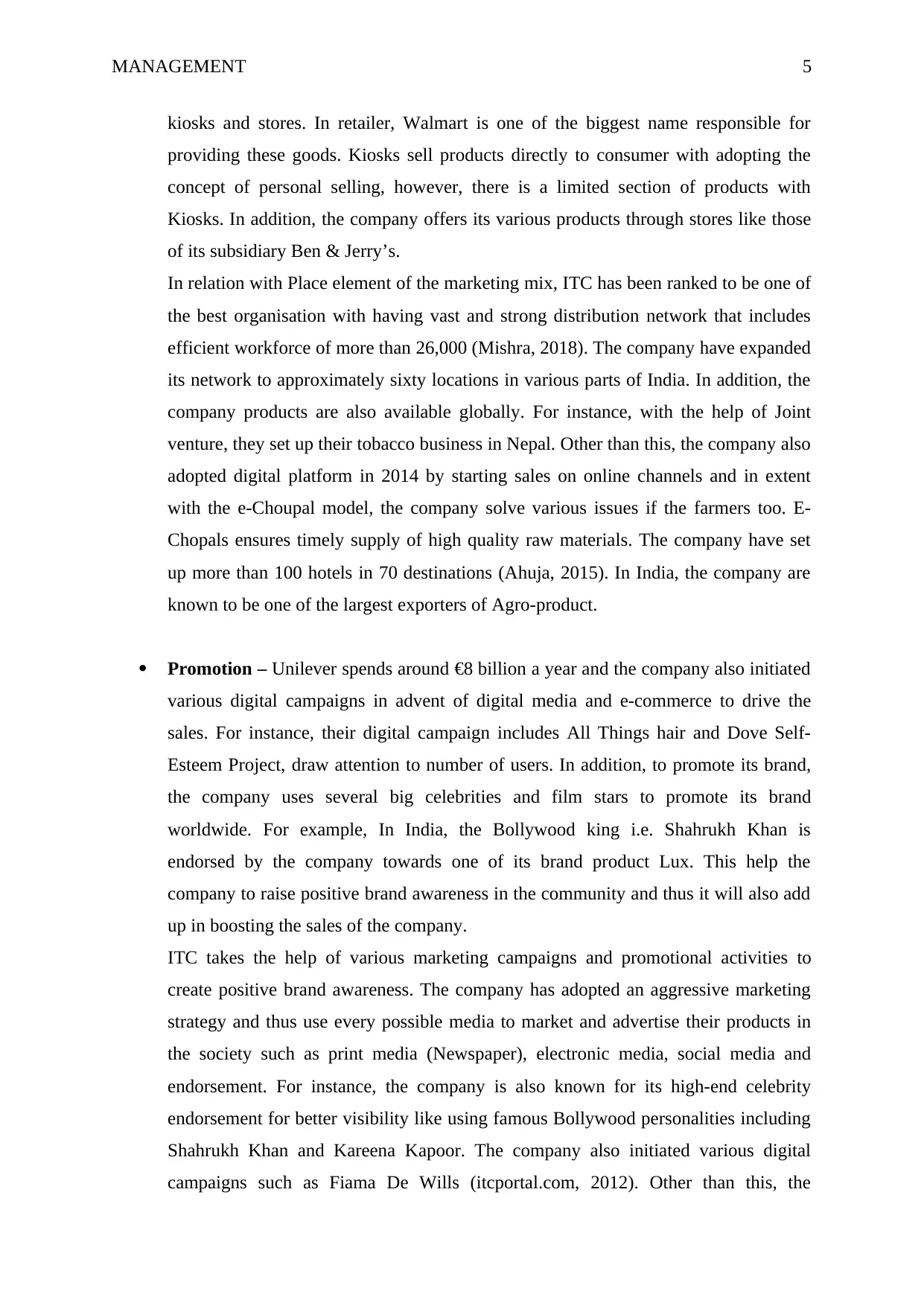
MANAGEMENT 5
kiosks and stores. In retailer, Walmart is one of the biggest name responsible for
providing these goods. Kiosks sell products directly to consumer with adopting the
concept of personal selling, however, there is a limited section of products with
Kiosks. In addition, the company offers its various products through stores like those
of its subsidiary Ben & Jerry’s.
In relation with Place element of the marketing mix, ITC has been ranked to be one of
the best organisation with having vast and strong distribution network that includes
efficient workforce of more than 26,000 (Mishra, 2018). The company have expanded
its network to approximately sixty locations in various parts of India. In addition, the
company products are also available globally. For instance, with the help of Joint
venture, they set up their tobacco business in Nepal. Other than this, the company also
adopted digital platform in 2014 by starting sales on online channels and in extent
with the e-Choupal model, the company solve various issues if the farmers too. E-
Chopals ensures timely supply of high quality raw materials. The company have set
up more than 100 hotels in 70 destinations (Ahuja, 2015). In India, the company are
known to be one of the largest exporters of Agro-product.
Promotion – Unilever spends around €8 billion a year and the company also initiated
various digital campaigns in advent of digital media and e-commerce to drive the
sales. For instance, their digital campaign includes All Things hair and Dove Self-
Esteem Project, draw attention to number of users. In addition, to promote its brand,
the company uses several big celebrities and film stars to promote its brand
worldwide. For example, In India, the Bollywood king i.e. Shahrukh Khan is
endorsed by the company towards one of its brand product Lux. This help the
company to raise positive brand awareness in the community and thus it will also add
up in boosting the sales of the company.
ITC takes the help of various marketing campaigns and promotional activities to
create positive brand awareness. The company has adopted an aggressive marketing
strategy and thus use every possible media to market and advertise their products in
the society such as print media (Newspaper), electronic media, social media and
endorsement. For instance, the company is also known for its high-end celebrity
endorsement for better visibility like using famous Bollywood personalities including
Shahrukh Khan and Kareena Kapoor. The company also initiated various digital
campaigns such as Fiama De Wills (itcportal.com, 2012). Other than this, the
kiosks and stores. In retailer, Walmart is one of the biggest name responsible for
providing these goods. Kiosks sell products directly to consumer with adopting the
concept of personal selling, however, there is a limited section of products with
Kiosks. In addition, the company offers its various products through stores like those
of its subsidiary Ben & Jerry’s.
In relation with Place element of the marketing mix, ITC has been ranked to be one of
the best organisation with having vast and strong distribution network that includes
efficient workforce of more than 26,000 (Mishra, 2018). The company have expanded
its network to approximately sixty locations in various parts of India. In addition, the
company products are also available globally. For instance, with the help of Joint
venture, they set up their tobacco business in Nepal. Other than this, the company also
adopted digital platform in 2014 by starting sales on online channels and in extent
with the e-Choupal model, the company solve various issues if the farmers too. E-
Chopals ensures timely supply of high quality raw materials. The company have set
up more than 100 hotels in 70 destinations (Ahuja, 2015). In India, the company are
known to be one of the largest exporters of Agro-product.
Promotion – Unilever spends around €8 billion a year and the company also initiated
various digital campaigns in advent of digital media and e-commerce to drive the
sales. For instance, their digital campaign includes All Things hair and Dove Self-
Esteem Project, draw attention to number of users. In addition, to promote its brand,
the company uses several big celebrities and film stars to promote its brand
worldwide. For example, In India, the Bollywood king i.e. Shahrukh Khan is
endorsed by the company towards one of its brand product Lux. This help the
company to raise positive brand awareness in the community and thus it will also add
up in boosting the sales of the company.
ITC takes the help of various marketing campaigns and promotional activities to
create positive brand awareness. The company has adopted an aggressive marketing
strategy and thus use every possible media to market and advertise their products in
the society such as print media (Newspaper), electronic media, social media and
endorsement. For instance, the company is also known for its high-end celebrity
endorsement for better visibility like using famous Bollywood personalities including
Shahrukh Khan and Kareena Kapoor. The company also initiated various digital
campaigns such as Fiama De Wills (itcportal.com, 2012). Other than this, the
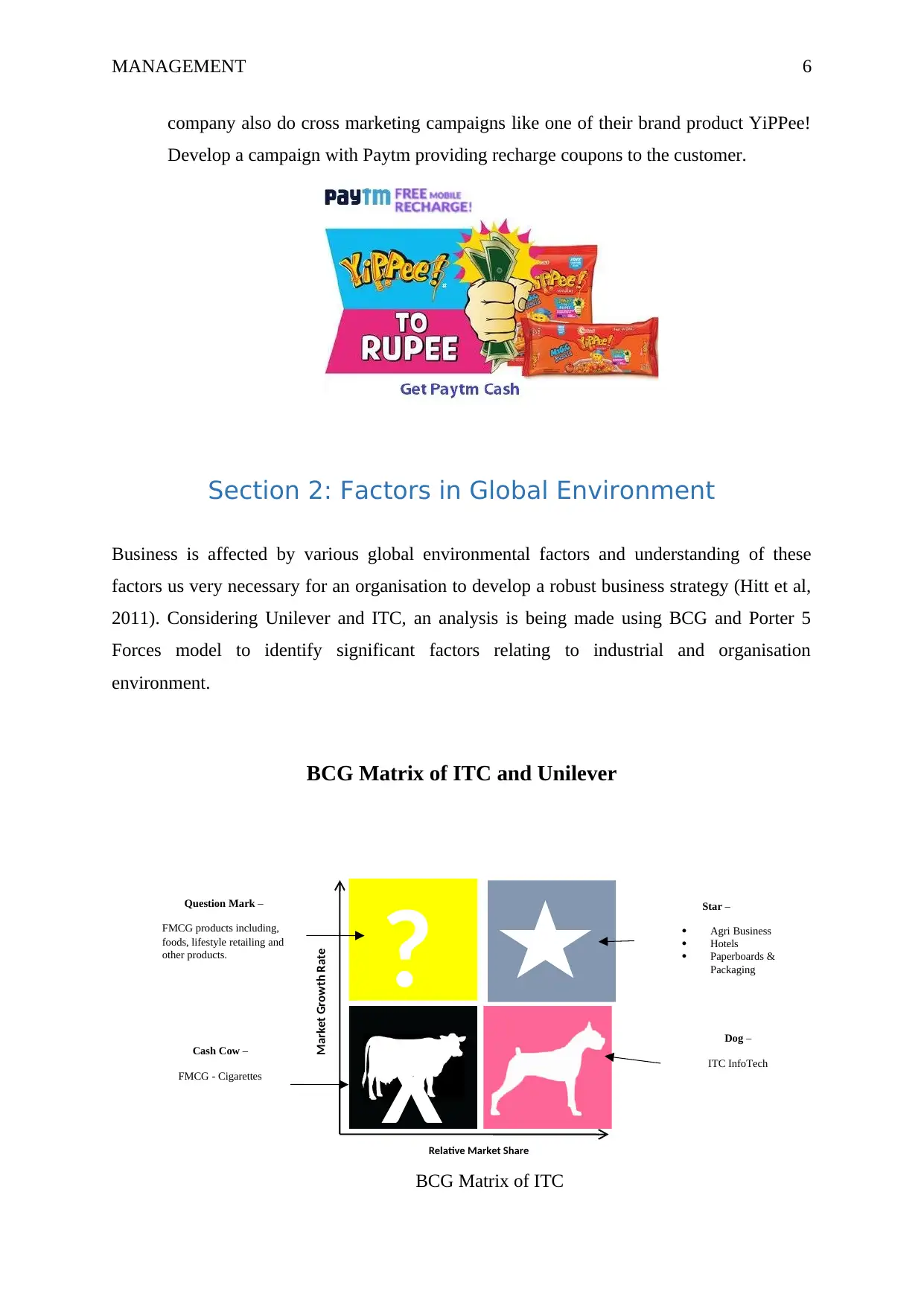
MANAGEMENT 6
company also do cross marketing campaigns like one of their brand product YiPPee!
Develop a campaign with Paytm providing recharge coupons to the customer.
Section 2: Factors in Global Environment
Business is affected by various global environmental factors and understanding of these
factors us very necessary for an organisation to develop a robust business strategy (Hitt et al,
2011). Considering Unilever and ITC, an analysis is being made using BCG and Porter 5
Forces model to identify significant factors relating to industrial and organisation
environment.
BCG Matrix of ITC and Unilever
BCG Matrix of ITC
?
XRelative Market Share
Market Growth Rate
Star –
Agri Business
Hotels
Paperboards &
Packaging
Question Mark –
FMCG products including,
foods, lifestyle retailing and
other products.
Cash Cow –
FMCG - Cigarettes
Dog –
ITC InfoTech
company also do cross marketing campaigns like one of their brand product YiPPee!
Develop a campaign with Paytm providing recharge coupons to the customer.
Section 2: Factors in Global Environment
Business is affected by various global environmental factors and understanding of these
factors us very necessary for an organisation to develop a robust business strategy (Hitt et al,
2011). Considering Unilever and ITC, an analysis is being made using BCG and Porter 5
Forces model to identify significant factors relating to industrial and organisation
environment.
BCG Matrix of ITC and Unilever
BCG Matrix of ITC
?
XRelative Market Share
Market Growth Rate
Star –
Agri Business
Hotels
Paperboards &
Packaging
Question Mark –
FMCG products including,
foods, lifestyle retailing and
other products.
Cash Cow –
FMCG - Cigarettes
Dog –
ITC InfoTech
Paraphrase This Document
Need a fresh take? Get an instant paraphrase of this document with our AI Paraphraser
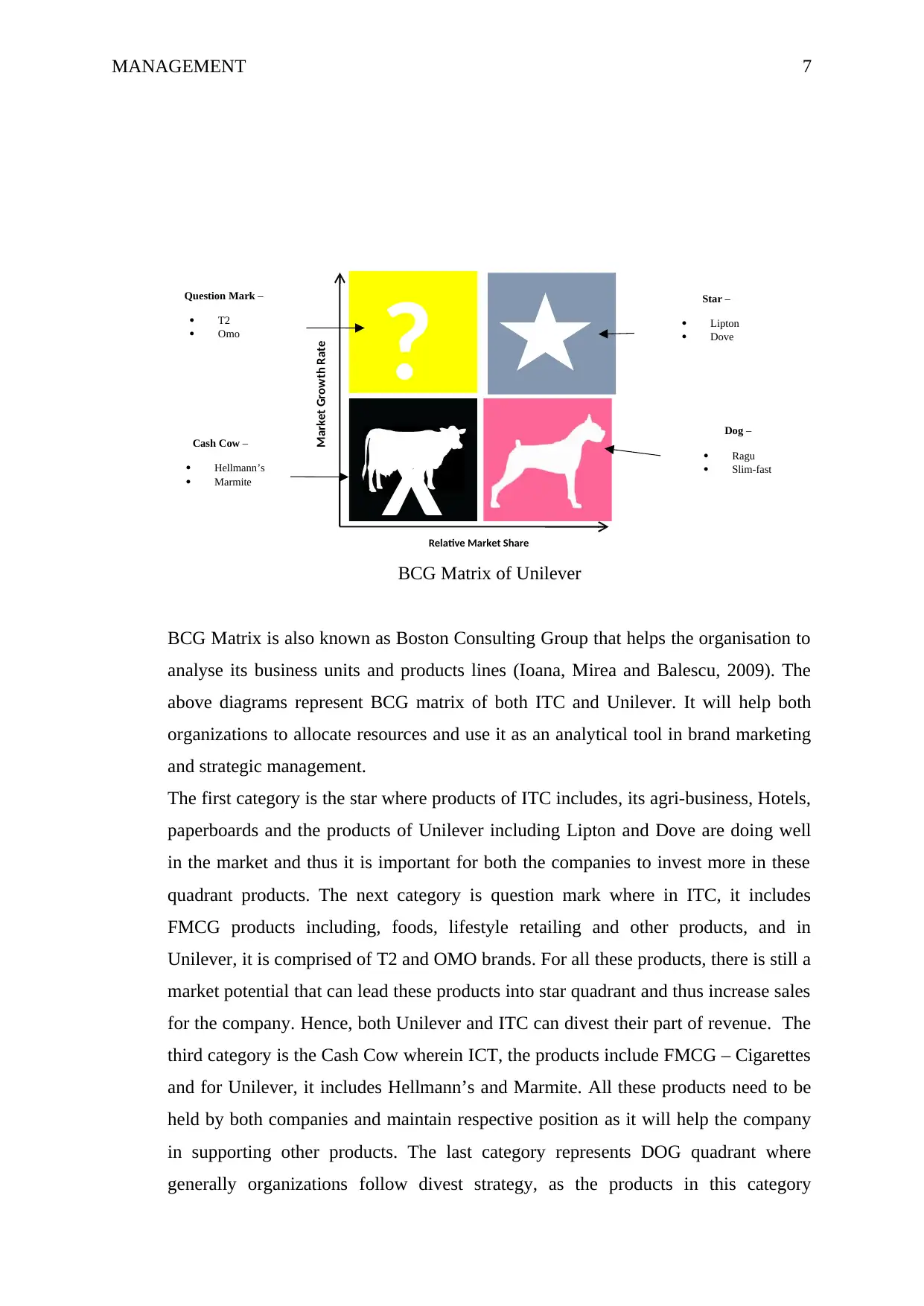
MANAGEMENT 7
BCG Matrix of Unilever
BCG Matrix is also known as Boston Consulting Group that helps the organisation to
analyse its business units and products lines (Ioana, Mirea and Balescu, 2009). The
above diagrams represent BCG matrix of both ITC and Unilever. It will help both
organizations to allocate resources and use it as an analytical tool in brand marketing
and strategic management.
The first category is the star where products of ITC includes, its agri-business, Hotels,
paperboards and the products of Unilever including Lipton and Dove are doing well
in the market and thus it is important for both the companies to invest more in these
quadrant products. The next category is question mark where in ITC, it includes
FMCG products including, foods, lifestyle retailing and other products, and in
Unilever, it is comprised of T2 and OMO brands. For all these products, there is still a
market potential that can lead these products into star quadrant and thus increase sales
for the company. Hence, both Unilever and ITC can divest their part of revenue. The
third category is the Cash Cow wherein ICT, the products include FMCG – Cigarettes
and for Unilever, it includes Hellmann’s and Marmite. All these products need to be
held by both companies and maintain respective position as it will help the company
in supporting other products. The last category represents DOG quadrant where
generally organizations follow divest strategy, as the products in this category
?
XRelative Market Share
Market Growth Rate
Star –
Lipton
Dove
Question Mark –
T2
Omo
Cash Cow –
Hellmann’s
Marmite
Dog –
Ragu
Slim-fast
BCG Matrix of Unilever
BCG Matrix is also known as Boston Consulting Group that helps the organisation to
analyse its business units and products lines (Ioana, Mirea and Balescu, 2009). The
above diagrams represent BCG matrix of both ITC and Unilever. It will help both
organizations to allocate resources and use it as an analytical tool in brand marketing
and strategic management.
The first category is the star where products of ITC includes, its agri-business, Hotels,
paperboards and the products of Unilever including Lipton and Dove are doing well
in the market and thus it is important for both the companies to invest more in these
quadrant products. The next category is question mark where in ITC, it includes
FMCG products including, foods, lifestyle retailing and other products, and in
Unilever, it is comprised of T2 and OMO brands. For all these products, there is still a
market potential that can lead these products into star quadrant and thus increase sales
for the company. Hence, both Unilever and ITC can divest their part of revenue. The
third category is the Cash Cow wherein ICT, the products include FMCG – Cigarettes
and for Unilever, it includes Hellmann’s and Marmite. All these products need to be
held by both companies and maintain respective position as it will help the company
in supporting other products. The last category represents DOG quadrant where
generally organizations follow divest strategy, as the products in this category
?
XRelative Market Share
Market Growth Rate
Star –
Lipton
Dove
Question Mark –
T2
Omo
Cash Cow –
Hellmann’s
Marmite
Dog –
Ragu
Slim-fast
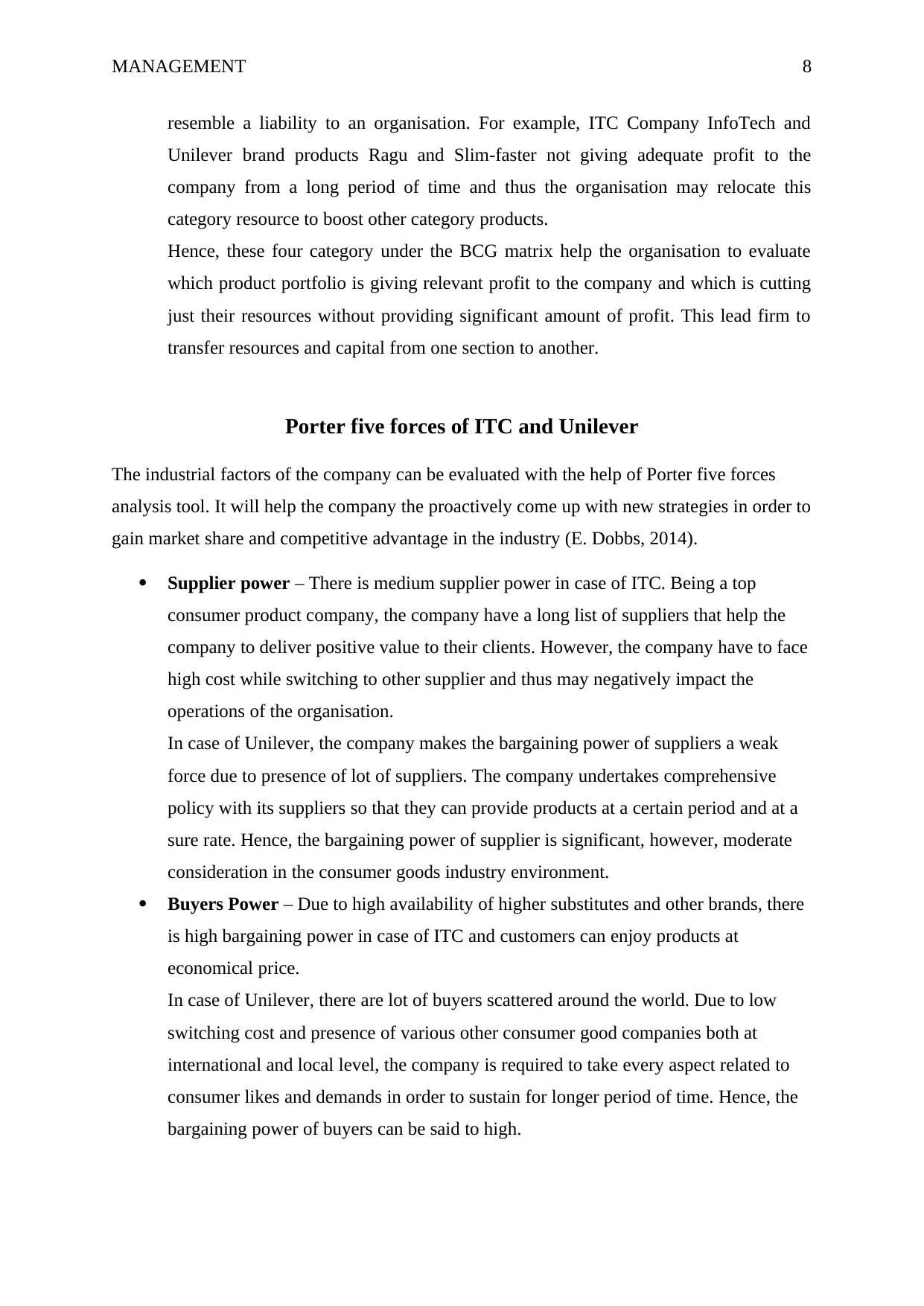
MANAGEMENT 8
resemble a liability to an organisation. For example, ITC Company InfoTech and
Unilever brand products Ragu and Slim-faster not giving adequate profit to the
company from a long period of time and thus the organisation may relocate this
category resource to boost other category products.
Hence, these four category under the BCG matrix help the organisation to evaluate
which product portfolio is giving relevant profit to the company and which is cutting
just their resources without providing significant amount of profit. This lead firm to
transfer resources and capital from one section to another.
Porter five forces of ITC and Unilever
The industrial factors of the company can be evaluated with the help of Porter five forces
analysis tool. It will help the company the proactively come up with new strategies in order to
gain market share and competitive advantage in the industry (E. Dobbs, 2014).
Supplier power – There is medium supplier power in case of ITC. Being a top
consumer product company, the company have a long list of suppliers that help the
company to deliver positive value to their clients. However, the company have to face
high cost while switching to other supplier and thus may negatively impact the
operations of the organisation.
In case of Unilever, the company makes the bargaining power of suppliers a weak
force due to presence of lot of suppliers. The company undertakes comprehensive
policy with its suppliers so that they can provide products at a certain period and at a
sure rate. Hence, the bargaining power of supplier is significant, however, moderate
consideration in the consumer goods industry environment.
Buyers Power – Due to high availability of higher substitutes and other brands, there
is high bargaining power in case of ITC and customers can enjoy products at
economical price.
In case of Unilever, there are lot of buyers scattered around the world. Due to low
switching cost and presence of various other consumer good companies both at
international and local level, the company is required to take every aspect related to
consumer likes and demands in order to sustain for longer period of time. Hence, the
bargaining power of buyers can be said to high.
resemble a liability to an organisation. For example, ITC Company InfoTech and
Unilever brand products Ragu and Slim-faster not giving adequate profit to the
company from a long period of time and thus the organisation may relocate this
category resource to boost other category products.
Hence, these four category under the BCG matrix help the organisation to evaluate
which product portfolio is giving relevant profit to the company and which is cutting
just their resources without providing significant amount of profit. This lead firm to
transfer resources and capital from one section to another.
Porter five forces of ITC and Unilever
The industrial factors of the company can be evaluated with the help of Porter five forces
analysis tool. It will help the company the proactively come up with new strategies in order to
gain market share and competitive advantage in the industry (E. Dobbs, 2014).
Supplier power – There is medium supplier power in case of ITC. Being a top
consumer product company, the company have a long list of suppliers that help the
company to deliver positive value to their clients. However, the company have to face
high cost while switching to other supplier and thus may negatively impact the
operations of the organisation.
In case of Unilever, the company makes the bargaining power of suppliers a weak
force due to presence of lot of suppliers. The company undertakes comprehensive
policy with its suppliers so that they can provide products at a certain period and at a
sure rate. Hence, the bargaining power of supplier is significant, however, moderate
consideration in the consumer goods industry environment.
Buyers Power – Due to high availability of higher substitutes and other brands, there
is high bargaining power in case of ITC and customers can enjoy products at
economical price.
In case of Unilever, there are lot of buyers scattered around the world. Due to low
switching cost and presence of various other consumer good companies both at
international and local level, the company is required to take every aspect related to
consumer likes and demands in order to sustain for longer period of time. Hence, the
bargaining power of buyers can be said to high.
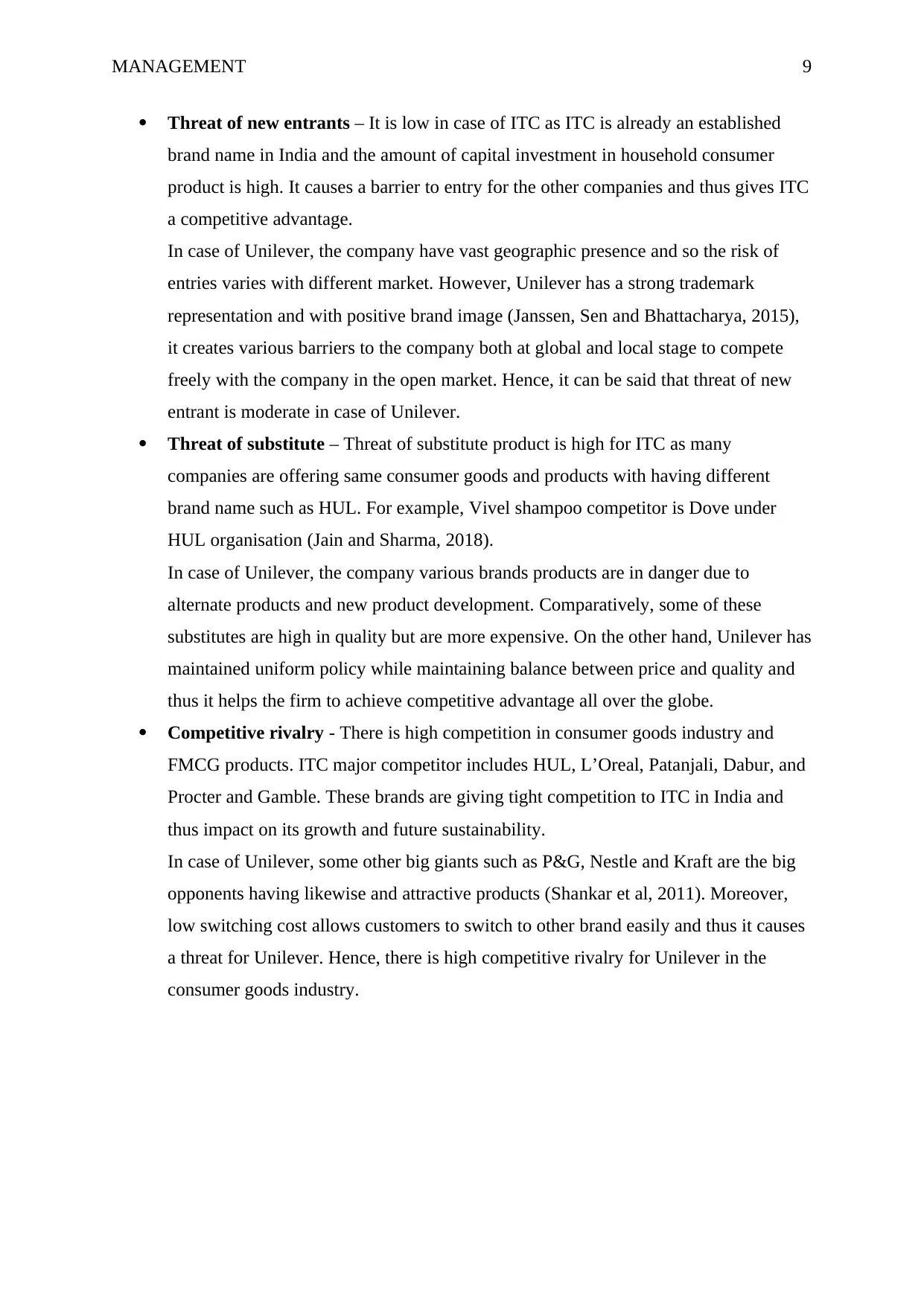
MANAGEMENT 9
Threat of new entrants – It is low in case of ITC as ITC is already an established
brand name in India and the amount of capital investment in household consumer
product is high. It causes a barrier to entry for the other companies and thus gives ITC
a competitive advantage.
In case of Unilever, the company have vast geographic presence and so the risk of
entries varies with different market. However, Unilever has a strong trademark
representation and with positive brand image (Janssen, Sen and Bhattacharya, 2015),
it creates various barriers to the company both at global and local stage to compete
freely with the company in the open market. Hence, it can be said that threat of new
entrant is moderate in case of Unilever.
Threat of substitute – Threat of substitute product is high for ITC as many
companies are offering same consumer goods and products with having different
brand name such as HUL. For example, Vivel shampoo competitor is Dove under
HUL organisation (Jain and Sharma, 2018).
In case of Unilever, the company various brands products are in danger due to
alternate products and new product development. Comparatively, some of these
substitutes are high in quality but are more expensive. On the other hand, Unilever has
maintained uniform policy while maintaining balance between price and quality and
thus it helps the firm to achieve competitive advantage all over the globe.
Competitive rivalry - There is high competition in consumer goods industry and
FMCG products. ITC major competitor includes HUL, L’Oreal, Patanjali, Dabur, and
Procter and Gamble. These brands are giving tight competition to ITC in India and
thus impact on its growth and future sustainability.
In case of Unilever, some other big giants such as P&G, Nestle and Kraft are the big
opponents having likewise and attractive products (Shankar et al, 2011). Moreover,
low switching cost allows customers to switch to other brand easily and thus it causes
a threat for Unilever. Hence, there is high competitive rivalry for Unilever in the
consumer goods industry.
Threat of new entrants – It is low in case of ITC as ITC is already an established
brand name in India and the amount of capital investment in household consumer
product is high. It causes a barrier to entry for the other companies and thus gives ITC
a competitive advantage.
In case of Unilever, the company have vast geographic presence and so the risk of
entries varies with different market. However, Unilever has a strong trademark
representation and with positive brand image (Janssen, Sen and Bhattacharya, 2015),
it creates various barriers to the company both at global and local stage to compete
freely with the company in the open market. Hence, it can be said that threat of new
entrant is moderate in case of Unilever.
Threat of substitute – Threat of substitute product is high for ITC as many
companies are offering same consumer goods and products with having different
brand name such as HUL. For example, Vivel shampoo competitor is Dove under
HUL organisation (Jain and Sharma, 2018).
In case of Unilever, the company various brands products are in danger due to
alternate products and new product development. Comparatively, some of these
substitutes are high in quality but are more expensive. On the other hand, Unilever has
maintained uniform policy while maintaining balance between price and quality and
thus it helps the firm to achieve competitive advantage all over the globe.
Competitive rivalry - There is high competition in consumer goods industry and
FMCG products. ITC major competitor includes HUL, L’Oreal, Patanjali, Dabur, and
Procter and Gamble. These brands are giving tight competition to ITC in India and
thus impact on its growth and future sustainability.
In case of Unilever, some other big giants such as P&G, Nestle and Kraft are the big
opponents having likewise and attractive products (Shankar et al, 2011). Moreover,
low switching cost allows customers to switch to other brand easily and thus it causes
a threat for Unilever. Hence, there is high competitive rivalry for Unilever in the
consumer goods industry.
Secure Best Marks with AI Grader
Need help grading? Try our AI Grader for instant feedback on your assignments.
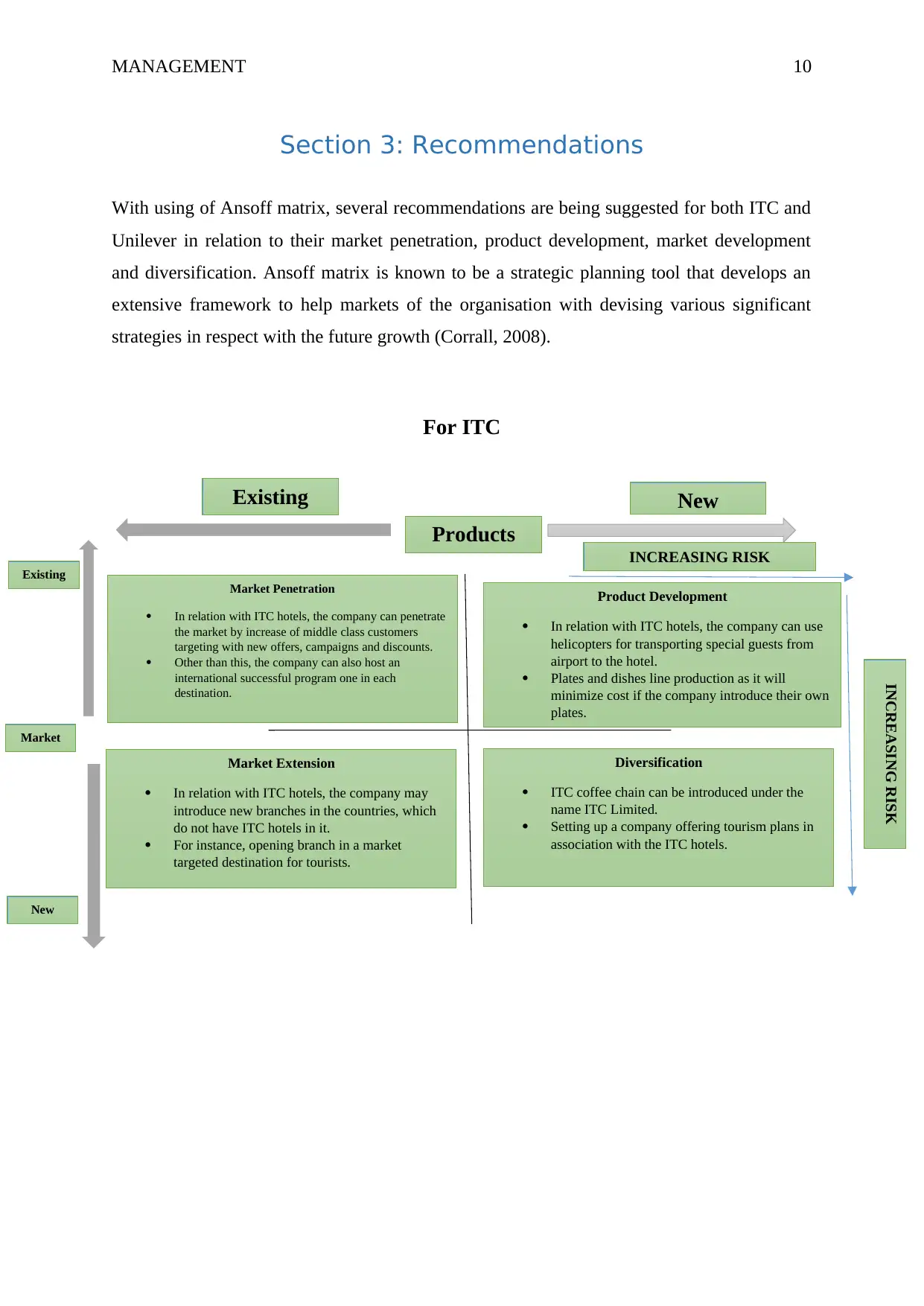
MANAGEMENT 10
Section 3: Recommendations
With using of Ansoff matrix, several recommendations are being suggested for both ITC and
Unilever in relation to their market penetration, product development, market development
and diversification. Ansoff matrix is known to be a strategic planning tool that develops an
extensive framework to help markets of the organisation with devising various significant
strategies in respect with the future growth (Corrall, 2008).
For ITC
Product Development
In relation with ITC hotels, the company can use
helicopters for transporting special guests from
airport to the hotel.
Plates and dishes line production as it will
minimize cost if the company introduce their own
plates.
Market Penetration
In relation with ITC hotels, the company can penetrate
the market by increase of middle class customers
targeting with new offers, campaigns and discounts.
Other than this, the company can also host an
international successful program one in each
destination.
Market Extension
In relation with ITC hotels, the company may
introduce new branches in the countries, which
do not have ITC hotels in it.
For instance, opening branch in a market
targeted destination for tourists.
Diversification
ITC coffee chain can be introduced under the
name ITC Limited.
Setting up a company offering tourism plans in
association with the ITC hotels.
Products
Existing New
INCREASING RISK
INCREASING RISK
Existing
Market
New
Section 3: Recommendations
With using of Ansoff matrix, several recommendations are being suggested for both ITC and
Unilever in relation to their market penetration, product development, market development
and diversification. Ansoff matrix is known to be a strategic planning tool that develops an
extensive framework to help markets of the organisation with devising various significant
strategies in respect with the future growth (Corrall, 2008).
For ITC
Product Development
In relation with ITC hotels, the company can use
helicopters for transporting special guests from
airport to the hotel.
Plates and dishes line production as it will
minimize cost if the company introduce their own
plates.
Market Penetration
In relation with ITC hotels, the company can penetrate
the market by increase of middle class customers
targeting with new offers, campaigns and discounts.
Other than this, the company can also host an
international successful program one in each
destination.
Market Extension
In relation with ITC hotels, the company may
introduce new branches in the countries, which
do not have ITC hotels in it.
For instance, opening branch in a market
targeted destination for tourists.
Diversification
ITC coffee chain can be introduced under the
name ITC Limited.
Setting up a company offering tourism plans in
association with the ITC hotels.
Products
Existing New
INCREASING RISK
INCREASING RISK
Existing
Market
New
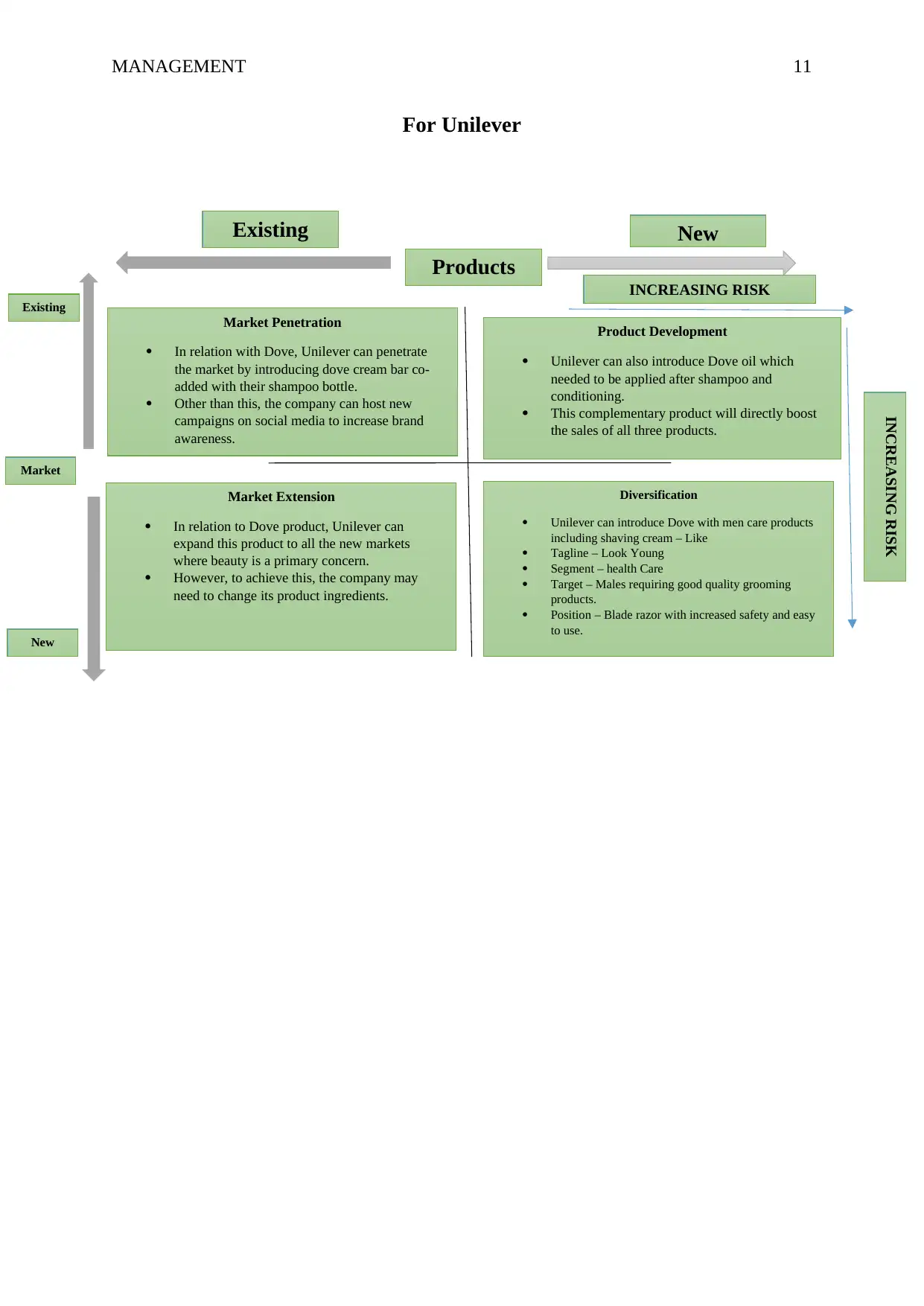
MANAGEMENT 11
For Unilever
Product Development
Unilever can also introduce Dove oil which
needed to be applied after shampoo and
conditioning.
This complementary product will directly boost
the sales of all three products.
Market Penetration
In relation with Dove, Unilever can penetrate
the market by introducing dove cream bar co-
added with their shampoo bottle.
Other than this, the company can host new
campaigns on social media to increase brand
awareness.
Market Extension
In relation to Dove product, Unilever can
expand this product to all the new markets
where beauty is a primary concern.
However, to achieve this, the company may
need to change its product ingredients.
Diversification
Unilever can introduce Dove with men care products
including shaving cream – Like
Tagline – Look Young
Segment – health Care
Target – Males requiring good quality grooming
products.
Position – Blade razor with increased safety and easy
to use.
Products
Existing New
INCREASING RISK
INCREASING RISK
Existing
Market
New
For Unilever
Product Development
Unilever can also introduce Dove oil which
needed to be applied after shampoo and
conditioning.
This complementary product will directly boost
the sales of all three products.
Market Penetration
In relation with Dove, Unilever can penetrate
the market by introducing dove cream bar co-
added with their shampoo bottle.
Other than this, the company can host new
campaigns on social media to increase brand
awareness.
Market Extension
In relation to Dove product, Unilever can
expand this product to all the new markets
where beauty is a primary concern.
However, to achieve this, the company may
need to change its product ingredients.
Diversification
Unilever can introduce Dove with men care products
including shaving cream – Like
Tagline – Look Young
Segment – health Care
Target – Males requiring good quality grooming
products.
Position – Blade razor with increased safety and easy
to use.
Products
Existing New
INCREASING RISK
INCREASING RISK
Existing
Market
New
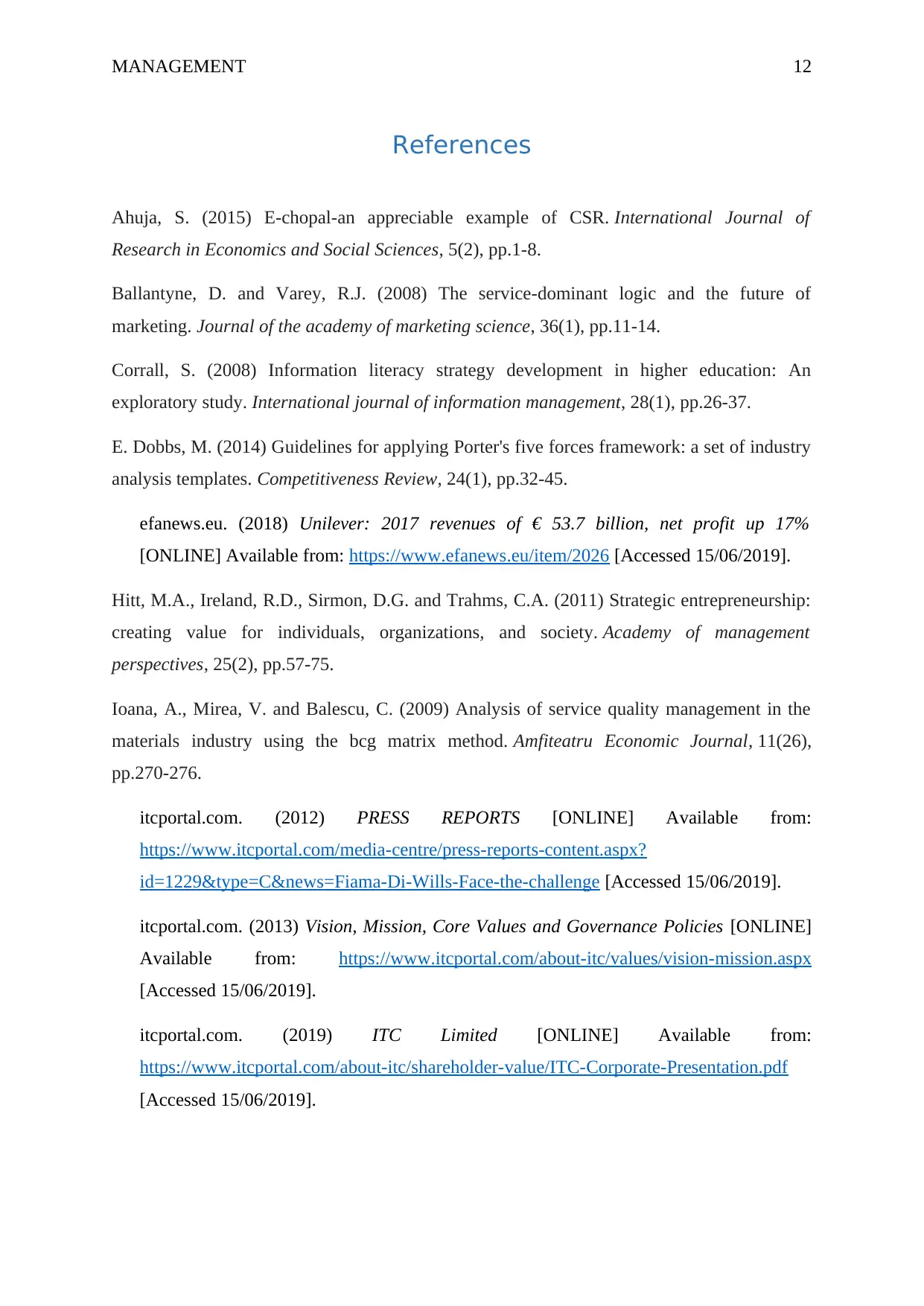
MANAGEMENT 12
References
Ahuja, S. (2015) E-chopal-an appreciable example of CSR. International Journal of
Research in Economics and Social Sciences, 5(2), pp.1-8.
Ballantyne, D. and Varey, R.J. (2008) The service-dominant logic and the future of
marketing. Journal of the academy of marketing science, 36(1), pp.11-14.
Corrall, S. (2008) Information literacy strategy development in higher education: An
exploratory study. International journal of information management, 28(1), pp.26-37.
E. Dobbs, M. (2014) Guidelines for applying Porter's five forces framework: a set of industry
analysis templates. Competitiveness Review, 24(1), pp.32-45.
efanews.eu. (2018) Unilever: 2017 revenues of € 53.7 billion, net profit up 17%
[ONLINE] Available from: https://www.efanews.eu/item/2026 [Accessed 15/06/2019].
Hitt, M.A., Ireland, R.D., Sirmon, D.G. and Trahms, C.A. (2011) Strategic entrepreneurship:
creating value for individuals, organizations, and society. Academy of management
perspectives, 25(2), pp.57-75.
Ioana, A., Mirea, V. and Balescu, C. (2009) Analysis of service quality management in the
materials industry using the bcg matrix method. Amfiteatru Economic Journal, 11(26),
pp.270-276.
itcportal.com. (2012) PRESS REPORTS [ONLINE] Available from:
https://www.itcportal.com/media-centre/press-reports-content.aspx?
id=1229&type=C&news=Fiama-Di-Wills-Face-the-challenge [Accessed 15/06/2019].
itcportal.com. (2013) Vision, Mission, Core Values and Governance Policies [ONLINE]
Available from: https://www.itcportal.com/about-itc/values/vision-mission.aspx
[Accessed 15/06/2019].
itcportal.com. (2019) ITC Limited [ONLINE] Available from:
https://www.itcportal.com/about-itc/shareholder-value/ITC-Corporate-Presentation.pdf
[Accessed 15/06/2019].
References
Ahuja, S. (2015) E-chopal-an appreciable example of CSR. International Journal of
Research in Economics and Social Sciences, 5(2), pp.1-8.
Ballantyne, D. and Varey, R.J. (2008) The service-dominant logic and the future of
marketing. Journal of the academy of marketing science, 36(1), pp.11-14.
Corrall, S. (2008) Information literacy strategy development in higher education: An
exploratory study. International journal of information management, 28(1), pp.26-37.
E. Dobbs, M. (2014) Guidelines for applying Porter's five forces framework: a set of industry
analysis templates. Competitiveness Review, 24(1), pp.32-45.
efanews.eu. (2018) Unilever: 2017 revenues of € 53.7 billion, net profit up 17%
[ONLINE] Available from: https://www.efanews.eu/item/2026 [Accessed 15/06/2019].
Hitt, M.A., Ireland, R.D., Sirmon, D.G. and Trahms, C.A. (2011) Strategic entrepreneurship:
creating value for individuals, organizations, and society. Academy of management
perspectives, 25(2), pp.57-75.
Ioana, A., Mirea, V. and Balescu, C. (2009) Analysis of service quality management in the
materials industry using the bcg matrix method. Amfiteatru Economic Journal, 11(26),
pp.270-276.
itcportal.com. (2012) PRESS REPORTS [ONLINE] Available from:
https://www.itcportal.com/media-centre/press-reports-content.aspx?
id=1229&type=C&news=Fiama-Di-Wills-Face-the-challenge [Accessed 15/06/2019].
itcportal.com. (2013) Vision, Mission, Core Values and Governance Policies [ONLINE]
Available from: https://www.itcportal.com/about-itc/values/vision-mission.aspx
[Accessed 15/06/2019].
itcportal.com. (2019) ITC Limited [ONLINE] Available from:
https://www.itcportal.com/about-itc/shareholder-value/ITC-Corporate-Presentation.pdf
[Accessed 15/06/2019].
Paraphrase This Document
Need a fresh take? Get an instant paraphrase of this document with our AI Paraphraser
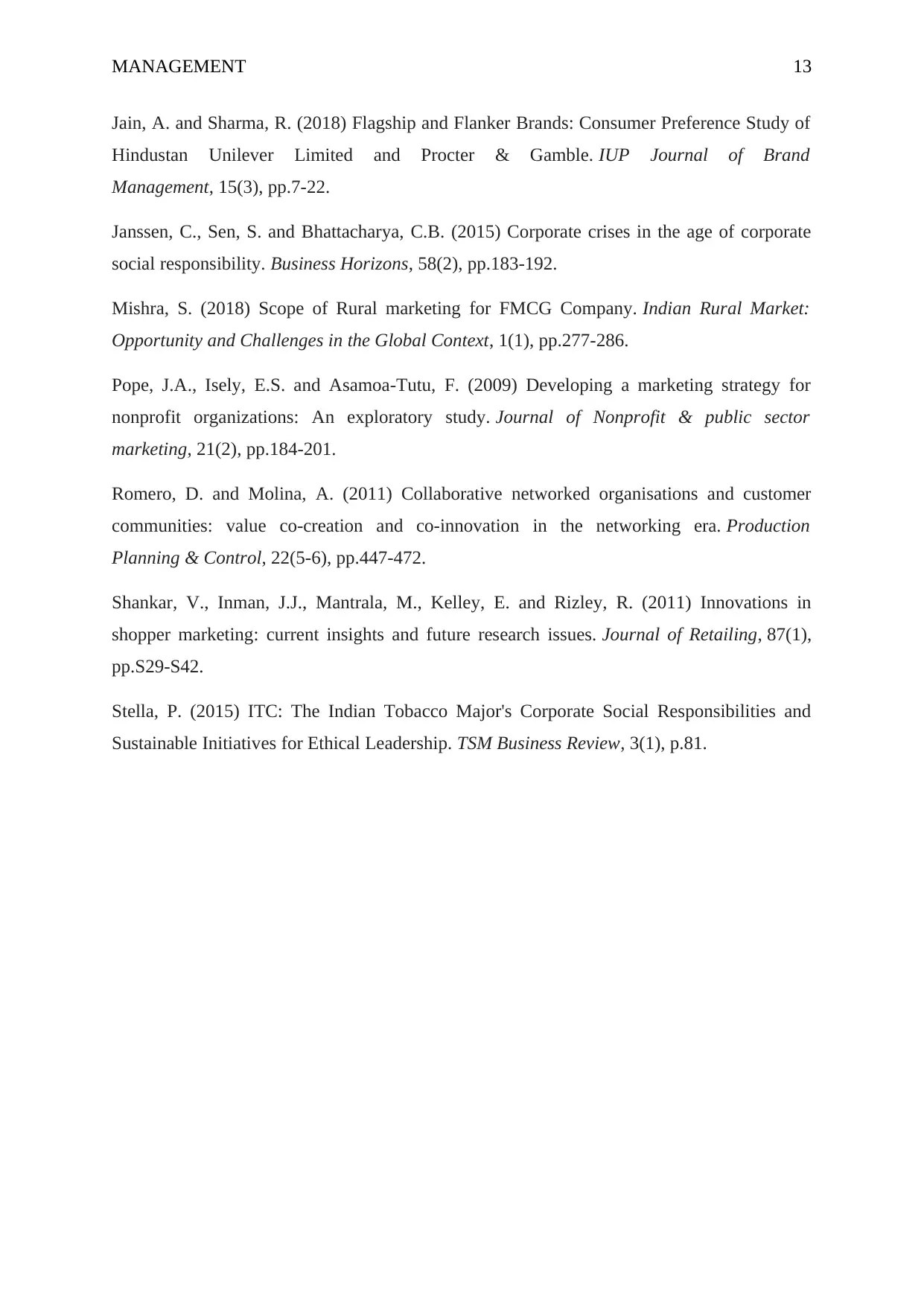
MANAGEMENT 13
Jain, A. and Sharma, R. (2018) Flagship and Flanker Brands: Consumer Preference Study of
Hindustan Unilever Limited and Procter & Gamble. IUP Journal of Brand
Management, 15(3), pp.7-22.
Janssen, C., Sen, S. and Bhattacharya, C.B. (2015) Corporate crises in the age of corporate
social responsibility. Business Horizons, 58(2), pp.183-192.
Mishra, S. (2018) Scope of Rural marketing for FMCG Company. Indian Rural Market:
Opportunity and Challenges in the Global Context, 1(1), pp.277-286.
Pope, J.A., Isely, E.S. and Asamoa‐Tutu, F. (2009) Developing a marketing strategy for
nonprofit organizations: An exploratory study. Journal of Nonprofit & public sector
marketing, 21(2), pp.184-201.
Romero, D. and Molina, A. (2011) Collaborative networked organisations and customer
communities: value co-creation and co-innovation in the networking era. Production
Planning & Control, 22(5-6), pp.447-472.
Shankar, V., Inman, J.J., Mantrala, M., Kelley, E. and Rizley, R. (2011) Innovations in
shopper marketing: current insights and future research issues. Journal of Retailing, 87(1),
pp.S29-S42.
Stella, P. (2015) ITC: The Indian Tobacco Major's Corporate Social Responsibilities and
Sustainable Initiatives for Ethical Leadership. TSM Business Review, 3(1), p.81.
Jain, A. and Sharma, R. (2018) Flagship and Flanker Brands: Consumer Preference Study of
Hindustan Unilever Limited and Procter & Gamble. IUP Journal of Brand
Management, 15(3), pp.7-22.
Janssen, C., Sen, S. and Bhattacharya, C.B. (2015) Corporate crises in the age of corporate
social responsibility. Business Horizons, 58(2), pp.183-192.
Mishra, S. (2018) Scope of Rural marketing for FMCG Company. Indian Rural Market:
Opportunity and Challenges in the Global Context, 1(1), pp.277-286.
Pope, J.A., Isely, E.S. and Asamoa‐Tutu, F. (2009) Developing a marketing strategy for
nonprofit organizations: An exploratory study. Journal of Nonprofit & public sector
marketing, 21(2), pp.184-201.
Romero, D. and Molina, A. (2011) Collaborative networked organisations and customer
communities: value co-creation and co-innovation in the networking era. Production
Planning & Control, 22(5-6), pp.447-472.
Shankar, V., Inman, J.J., Mantrala, M., Kelley, E. and Rizley, R. (2011) Innovations in
shopper marketing: current insights and future research issues. Journal of Retailing, 87(1),
pp.S29-S42.
Stella, P. (2015) ITC: The Indian Tobacco Major's Corporate Social Responsibilities and
Sustainable Initiatives for Ethical Leadership. TSM Business Review, 3(1), p.81.
1 out of 14
Related Documents
Your All-in-One AI-Powered Toolkit for Academic Success.
+13062052269
info@desklib.com
Available 24*7 on WhatsApp / Email
![[object Object]](/_next/static/media/star-bottom.7253800d.svg)
Unlock your academic potential
© 2024 | Zucol Services PVT LTD | All rights reserved.




